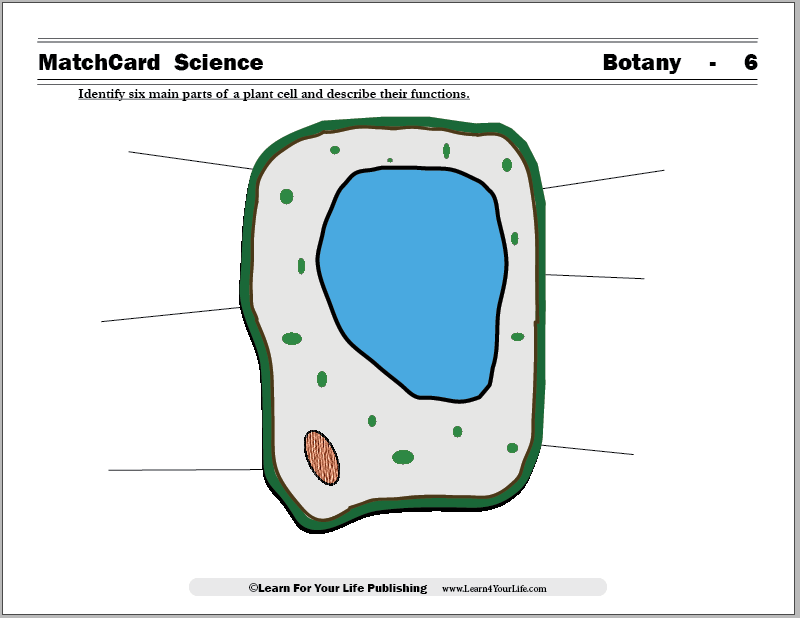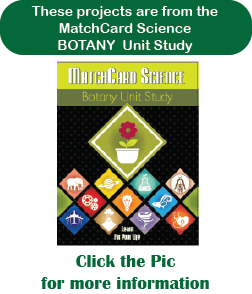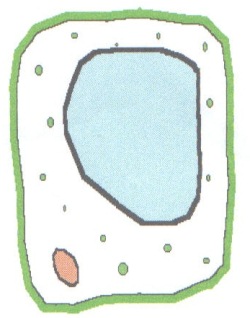Plant Cell Diagram
Identify Cell Parts on the Worksheet
Can you identify the parts of the cell on the plant cell diagram?
Free Download Below


MatchCard Science Plant Cell Worksheet
Objective: Identify six main parts of a plant cell and describe their functions.MatchCard: Download below.
MatchCard Information Pieces list the following cell parts:
- Cell wall
- Cell membrane
- Nucleus
- Vacuole
- Cytoplasm
- Chloroplast.
Download and Use the Plant Cell MatchCard


This is MatchCard #6 of the Botany Unit Study.
What's on the Plant Cell Diagram?
This worksheet provides a basic illustration of cells and their most obvious parts. As students master these basics, they move on to more detailed organelles of the plant cell.






The cell "brain" contains all the directions for the cell's functions
Cell Wall
A fibrous covering found only in plant cells
Cell Membrane
A lining which allows water to go in and out of the cell
Cytoplasm
The "jelly" inside the cell which holds its shape
Chloroplasts
"Oxygen Factories" - Chlorophyll turns carbon dioxide into oxygen.
Vacuole
A sac of water
More Cell Organelles
In MatchCard Science we introduce cells while studying plants. More advanced information on cell parts is found in the zoology unit on 10 parts of animal cells. The two lessons can be combined and compared for a more thorough unit on cells.Plant and Animal Cells
So how do plant and animal cells compare? If you have already studied animal cells, the students will be happy to recognize a few organelles they have seen before. But there are some new ones.Both animal and plant cells have a cell membrane; but only the plant cell has a cell wall. This makes plant cells "stiffer" than animal cells.
And of course, only plant cells have chloroplasts. These organelles containe the chlorophyll which turns carbon dioxide into oxygen. Since we are lacking in these important cell parts, we are quite dependent on plants to provide the oxygen necessary for our survival.
Plant Cell Projects
Plant Cell Model
Use clay to build a model of a plant cell. You will definitely want green for the cell wall. Use other colors for the different organelles.One advantage of the cellular model is that it is three-dimensional. Students often see animal cell and plant cell diagrams, and naturally begin to think of them as flat, two dimensional objects. This is an incomplete view of the cell, which is easily overcome by using a 3-D model.
Other Options
Check Youtube videos for ideas on making cell models from jello, frosting, or candy.
You can also buy kits to make cell models.
Under the Microscope
Look at some plant cells under a microscope. It's exciting to identify the "real" parts in the microscopic world that they have already learned about in their own.Onions have particularly large cells that are easy to view under a microscope. You can buy prepared slides or make your own.
Crunch
Have a few carrot and celery sticks to munch on. Notice how cruncy they are? Ever find yourself gnawing on long strands of grass in a field?The cell wall of the plant is responsible for that crunch.
Compare the texture of a raw carrot and cooked carrot (or any other vegetable.) Check out the firmness both with your teeth and in your fingers. What conclusion can be made?
Cell Wall Experiment
How hot can a vegetable get before it's cell wall deteriorates? Can you design an experiment?Hmmm, that would require us to be able to measure "crunchy" or "spongy." Think of how raw celery will break when bent. You may develop a scale of crispness vs limpness to measure the strength of the cell wall.
Not convinced that it is the cell wall that gives vegetables their cripsy crunch? Note that meat, dairy, and eggs do not have the same tendency to go limp when heated.
MatchCard Science
How To Use MatchCards

Download the FREE MatchCard Science Instructor's Guide and see how MatchCards can make building their science knowledge base fun.
Botany Unit Study

Check out our entire Botany Unit Study with 11 objectives.
12 Science Unit Studies

Chemistry is only one of twelve complete unit studies for kids in 3rd to 8th grade.
Comprehensive objectives, hands-on projects, suggested science fair experiments, and the fun game-like MatchCards keep them interested in learning science. See all twelve MatchCard Science Unit Studies.
About Our Site
Hands-On Learning













